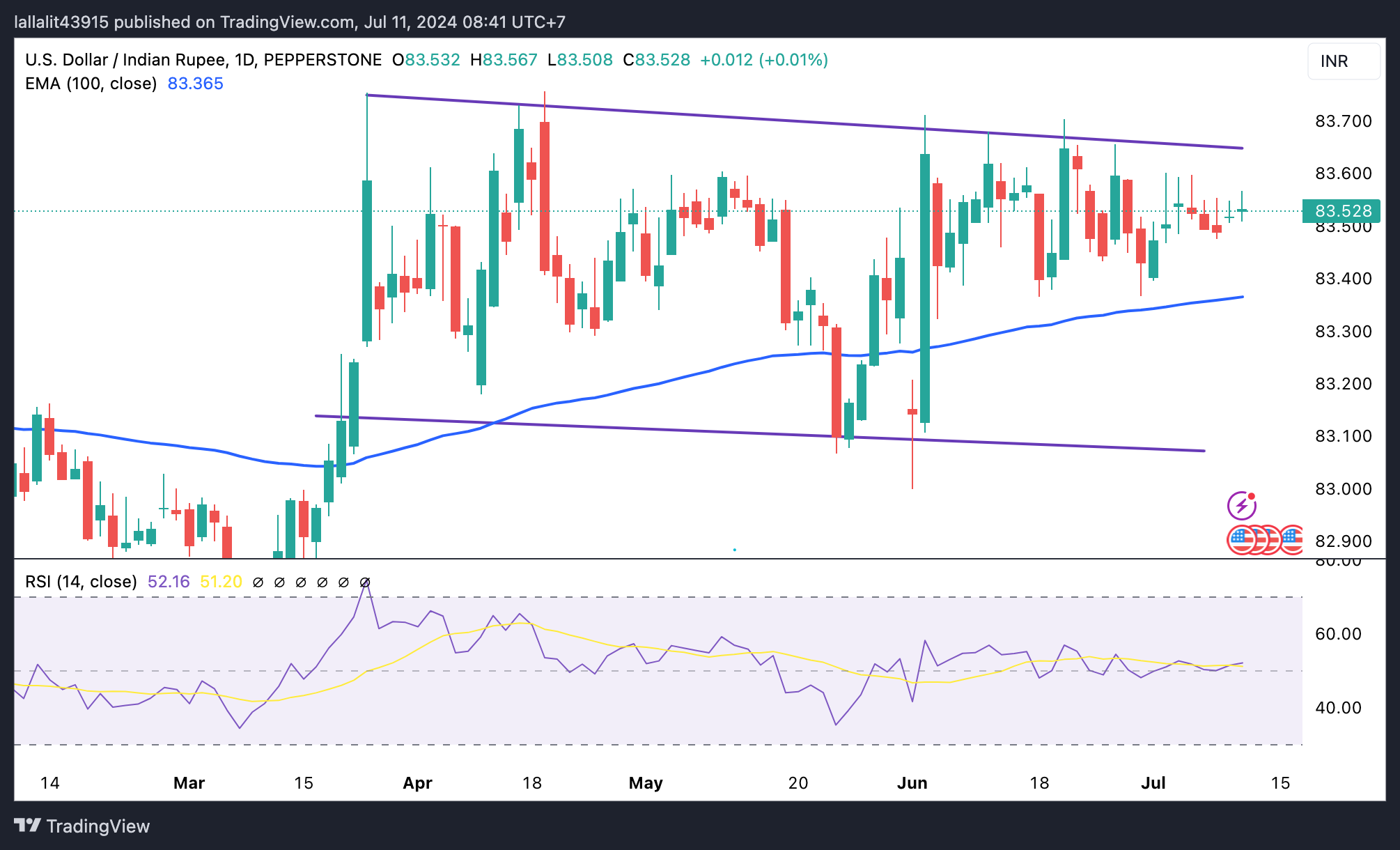- The Indian Rupee is higher in the Asian session on Thursday.
- Continued foreign capital inflows into India and falling crude oil prices support the INR.
- US Consumer Price Index (CPI) inflation data for June will be the highlight of Thursday.
The Indian Rupee (INR) strengthened on the back of a weakening US Dollar (USD) on Thursday. Moreover, sustained inflow of foreign funds into Indian markets and falling crude oil prices contributed to the INR’s rise. The pair’s upside remains limited on possible rate cuts by the US Federal Reserve (Fed), although Fed Chair Jerome Powell said the labor market was better balanced and acknowledged progress in slowing inflation without committing to cut rates.
However, renewed demand for the dollar from importers due to pressures from high oil prices could undermine the local currency as India is the world’s third-largest consumer of crude oil after the United States and China. Later on Thursday, investors will closely watch the release of the June Consumer Price Index (CPI) inflation data in the US. Further progress on inflation could lead to key changes in its policy statement paving the way for a rate cut in September.
Daily Market Wrap: Indian Rupee rebounds on foreign capital inflows into India, falling crude oil prices
- The Indian Rupee is expected to trade with a slightly bearish bias due to weakness in the domestic market and a positive tone in the US Dollar, said Anuj Choudhary, Research Analyst at Sharekhan by BNP Paribas.
- Fed Chairman Jerome Powell answered questions before the House Financial Services Committee on Wednesday, saying the Fed will make interest rate decisions based on data, incoming data, the evolving outlook and the balance of risks, rather than political factors.
- Powell also said it would not be appropriate to cut the policy rate until they have greater confidence that inflation is heading sustainably toward the Fed’s 2% target.
- Fed Governor Lisa Cook said on Thursday that U.S. inflation should continue to fall without a significant increase in the unemployment rate, according to Reuters.
- The probability of the Fed keeping the policy rate unchanged in September stood at almost 25% after this event, according to CME’s FedWatch tool.
- US CPI is projected to show a 3.1% year-on-year increase in June, while core inflation is expected to remain stable at 3.4% year-on-year.
Technical Analysis: USD/INR extends short-term consolidation
The Indian Rupee is trading higher on the day. The USD/INR pair maintains its bullish trend on the daily chart, with the pair holding above the 100-day exponential moving average (EMA).
In the near term, further consolidation remains in play as the pair has traded within a familiar range since March 21. The neutral momentum is also supported by the 14-day Relative Strength Index (RSI), which remains hovering around the mid-line of 50.
Sustained trading above the upper limit of the trading range at 83.65 will pave the way towards the all-time high of 83.75. Further north, the next hurdle is seen at the psychological barrier of 84.00.
On the other hand, a decisive break below the 100-day EMA at 83.36 could attract enough bearish demand towards the round mark of 83.00. The additional downside filter to watch is 82.82, a low from January 12.
US Dollar Price Today
The table below shows the percentage change of the US Dollar (USD) against the major currencies listed today. The US Dollar was the weakest against the Australian Dollar.
| USD | EUR | GBP | CAD | AUD | JPY | NZD | CHF | |
| USD | -0.05% | -0.04% | -0.01% | -0.09% | -0.01% | -0.07% | -0.07% | |
| EUR | 0.06% | 0.01% | 0.04% | -0.05% | 0.05% | -0.01% | 0.01% | |
| GBP | 0.05% | -0.01% | 0.05% | -0.06% | 0.03% | -0.02% | -0.02% | |
| CAD | 0.01% | -0.05% | -0.05% | -0.09% | 0.01% | -0.06% | -0.04% | |
| AUD | 0.09% | 0.05% | 0.05% | 0.09% | 0.07% | 0.05% | 0.05% | |
| JPY | 0.01% | -0.03% | -0.04% | 0.00% | -0.08% | -0.06% | -0.04% | |
| NZD | 0.07% | 0.01% | 0.01% | 0.08% | -0.04% | 0.06% | 0.01% | |
| CHF | 0.06% | -0.02% | 0.01% | 0.05% | -0.05% | 0.02% | 0.00% |
The heatmap shows the percentage changes of the major currencies relative to each other. The base currency is chosen from the left column, while the quote currency is chosen from the top row. For example, if you choose the Euro from the left column and move along the horizontal line to the Japanese Yen, the percentage change shown in the chart will represent EUR (base)/JPY (quote).
Source: Fx Street
I am Joshua Winder, a senior-level journalist and editor at World Stock Market. I specialize in covering news related to the stock market and economic trends. With more than 8 years of experience in this field, I have become an expert in financial reporting.








